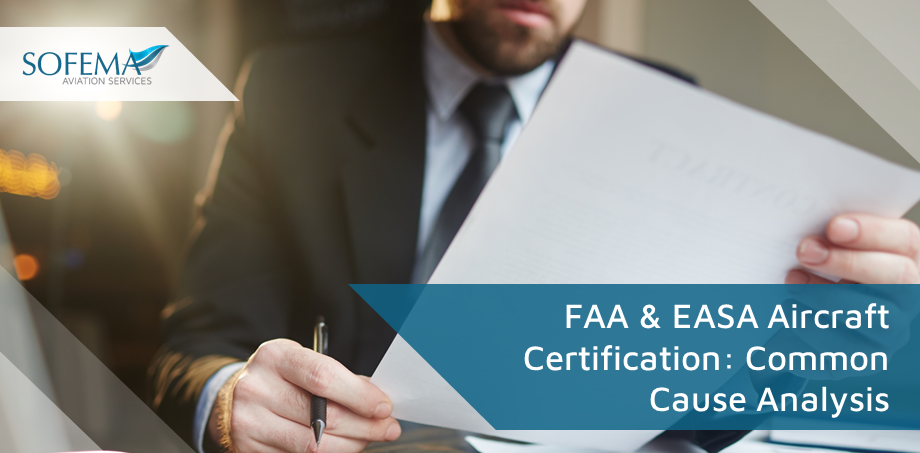Sofema Aviation Services (SAS) www.sassofia.com considers the process and methodology related to Common Cause Analysis (CCA) to comply with FAA 25-1309 and EASA CS 25-1309
Introduction
Common Cause Analysis (CCA) is a process used in the aviation industry to assess and manage the risks associated with multiple failures that have a common cause.
CCA is typically undertaken using a Multidisciplinary Team comprising experts from various domains, such as design engineers, system safety engineers, reliability engineers, human factors specialists, and subject matter experts relevant to the systems under analysis. This team will collectively analyze and evaluate potential common causes.
The first step in the Common Cause Analysis process is to become familiar with the relevant regulations and guidelines set forth by the regulatory authorities. This includes studying FAA 25-1309 and EASA CS 25-1309, which provide specific requirements and considerations related to common cause analysis in aircraft certification.
- This analysis is typically used to ensure that airplane systems are designed in a way that minimizes the risk of multiple system failures from a single cause.
- Aircraft Systems and their components shall be designed to minimize the probability of hazards caused by system failures and malfunctions.
Performing Common Cause Analysis
- The first step in the CCA process is to identify and define the problem.
o This involves determining the system or components that are the focus of the analysis, the type of failures that could occur, and the potential effects of those failures. (The scope should consider the criticality of the system or component, its impact on the aircraft’s safety, and any existing data or reports on related failures or incidents.)
- The next step is to collect and analyze data related to the system and its components.
o This includes reviewing previous failure reports, incident records, maintenance records, service history, design documentation, system specifications, and any available test data. The data collection process should also include inputs from operators, maintainers, and manufacturers.
- Failure Mode and Effects Analysis (FMEA) can be used as part of the CCA process for the identified systems or components. FMEA involves systematically identifying and analyzing potential failure modes, their effects, and their causes. This step helps in identifying failure modes that could potentially have common causes.
- Once the data has been analyzed, the next step is to identify potential common causes of failures. These could include:
o Design errors,
o Manufacturing defects,
o Environmental conditions,
o Human Error
o Operational Procedures
o (Plus, many others -dependent on the specific role)
- The potential risks associated with each identified common cause are then assessed.
- When considering the consequences of the failure modes, the probability of occurrence, and the level of control measures already in place. The team may use quantitative or qualitative methods, such as risk matrices or probabilistic analysis, to assess the risks associated with the identified common causes.
- This involves:
o Determining the likelihood of each common cause
o Determining the severity of the potential effects
o Considering the existing controls that could mitigate the risks.
- If the risk assessment determines that the risks associated with a common cause are too high Mitigation Strategies are introduced to address the identified common causes. The goal is to minimize or eliminate the risks associated with the potential common causes and ensure the safety and reliability of the aircraft.
- This could involve
o Changes to the system design
o Changes to the manufacturing processes
o Changes to the maintenance procedures
o Changes to other factors or other areas.
- The findings of the CCA are documented and reported.
o Document the entire Common Cause Analysis process, including the findings, analysis results, mitigation strategies, and validation outcomes.
o Prepare a comprehensive report that summarizes the analysis process, the identified common causes, and the corresponding mitigation measures.
o The report should comply with the documentation requirements specified by the regulatory authorities.
o The regulatory authorities may conduct their own evaluation and may request additional information or clarifications.
- Validate and verify the effectiveness of the mitigation strategies through analysis, testing, or simulation.
o This step ensures that the proposed solutions adequately address the identified common causes and reduce the risks to an acceptable level.
o Continue to assess their effectiveness throughout the life cycle of the aircraft.
- This includes monitoring the performance of the systems or components under analysis, analyzing failure data, and addressing any new findings or emerging common causes.
Next Steps
Follow this link to our Library to find & download related documents for Free.
Sofema Aviation Services (www.sassofia.com) offers training to cover CS 25 System Safety Assessments – Please see the following. If you have any comments or additional questions, don’t hesitate to email us at team@sassofia.com
Tags:
Aircraft Reliability, Airplane, aviation system safety, Common Cause Analysis (CCA), CS 25, EASA CS 25-1309, FAA 25-1309, Failure Mode and Effects Analysis (FMEA), SAS blogs, Sofema Aviation Services (SAS)




